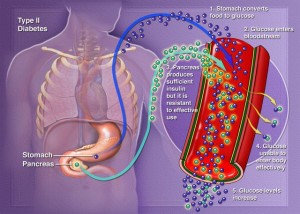It is estimated that one in three people with type 2 diabetes are not even aware they have it. Most of the food we eat is broken down into glucose, the form of sugar in the blood. Glucose is the main source of fuel for the body. Diabetes interferes with the body’s ability to metabolize carbohydrates for energy, leading to high levels of blood sugar. These chronically high blood sugar levels increase a person’s risk of developing nerve problems, vision loss, cardiovascular disease, and other conditions.
Type 2 diabetes – Glucose and Insulin
When we eat, the pancreas automatically produces the right amount of insulin to move glucose from bloodstream into our cells, which need it for growth and energy. For glucose to get into cells, insulin must be present. Insulin is a hormone produced by the pancreas. Insulin makes our body’s cells absorb glucose from the blood. The glucose is then stored in the liver and muscle as glycogen and stops the body from using fat as a source of energy.
In people with diabetes, however, the pancreas either produces little or no insulin, or the cells do not respond accordingly to the insulin. Glucose builds up in the blood, overflows into the urine, and passes out of the body. The body loses its main source of fuel even though the blood contains large amounts of sugar. Having too much glucose in your blood can cause serious problems. It can damage your eyes, kidneys, and nerves.
Symptoms
- Increased thirst and urinary frequency
- Increased hunger
- Weight loss
- Fatigue
- Blurred vision
- Slow-healing sores
- High blood pressure
- Frequent infections, such as gums, skin infections,vaginal or bladder infections
Treatment
Treatment for type 2 diabetes requires lifelong:
- Blood sugar monitoring
- Healthy eating
- Regular exercise
- Diabetes medication or insulin therapy
Contact your family doctor if you suspect you or a family member may have diabetes. Remember, the earlier type 2 diabetes is diagnosed, the sooner treatment can begin.




